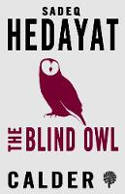
The world, he says, is ‘mean’ and comprised of ‘wretchedness and misery’ and people, moreover, exist only in order to cheat him.

Indeed, I have come across few novels that start so intensely, with so much melodrama and hand-wringing. The opening line, for example, describes ‘sores’ that ‘erode the mind.’ These sores are not literal, of course, but emotional or mental they are the product of a ‘disease’ for which relief, according to the unnamed narrator, is only to be found in wine and opium. The Blind Owl begins without preamble, which is to say that Hedayat does not ease the reader into his narrative, but immediately drops you into a tale of madness and despair. In this way, although owls are only briefly mentioned in the text, it is a fitting symbol for Sadeq Hedayat’s compelling Iranian novel. It looks like something you would conjure up in a nightmare or a drug-induced hallucination, where the real and familiar combines with the odd and unexpected. The reason for this is, I think, because, unlike the spider, it has a certain human quality also, but a humanity that has been horribly distorted. There is an abundance of astonishing, disconcertingly weird animal life – the spider, for example – but none of them quite have the captivating, eerie power of the owl.

Lion-headed razor-clawed black-eyed…a ghoul, in short, in a bird-like form.

What is it? A bird, but not really a bird, or certainly one like no other. Imagine blithely walking through the woods, through a forest, late one night and coming upon such a creature imagine, to be specific, coming upon a barn owl. Whenever anyone asks me why I like owls I always tell a short story, a fictional story of course, about the first man to ever see one.


 0 kommentar(er)
0 kommentar(er)
